Do All Weather Tires Work In Snow
This post contains affiliate links. As an Amazon Associate, we earn from qualifying purchases.
All-weather tires are effective in snow, especially in light to moderate conditions, due to their specialized tread patterns and rubber compounds that enhance grip. For those seeking a deeper understanding, further details and explanations will be provided later in the article.
Essential Facts in 30 Seconds
- All-weather tires offer better grip than all-season tires in light to moderate snow.
- They have 3PMSF certification, confirming reliable snow performance.
- Their special rubber remains soft down to -10°C for enhanced cold-weather traction.
- They are less effective than winter tires in deep snow.
- Best suited for mild winter regions with minimal heavy snowfall.
Understanding All Weather Tires
All-weather tires make driving easy in any season. They mix features of all-season and winter tires. These tires carry the 3PMSF certification for safety. Their soft rubber works well in cold weather. Unique tread patterns handle rain, snow, and dry roads. Deep grooves stop hydroplaning better than regular tires. Strong sidewalls add extra toughness for long use.
Care for your tires to keep them safe. Rotate them every 5,000 to 8,000 miles. This helps them wear evenly. Check tire pressure once a month. Match it to the maker’s advice. Look at tread depth often. Replace tires below 4/32 inches for better grip. All-weather tires are designed for year-round performance, balancing traction across diverse conditions year-round performance. They also provide better grip on snow and ice compared to standard all-season tires better snow grip.
Data shows all-weather tires last longer than winter ones. Yet, they wear out faster than all-season tires. Stick to these tips for safe drives!
Snow Performance Capabilities
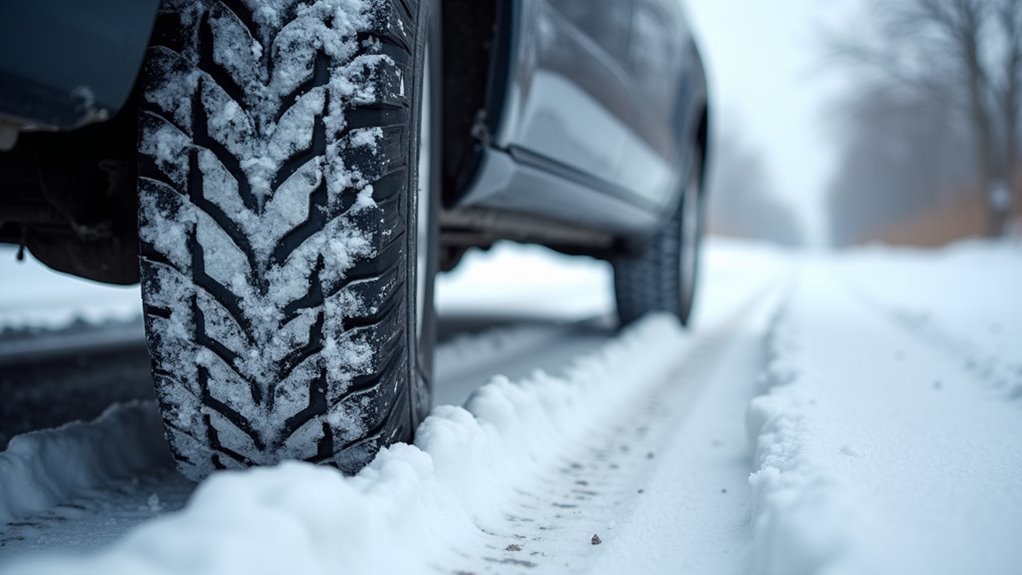
All-weather tires shine in snow, and I’ve got the details for you. They handle light to moderate snow really well. Special rubber stays soft even in cold, down to -10°C. This means better grip on snowy roads. They beat regular all-season tires on ice too. Still, they fall short of winter tires in deep snow.
Let’s break it down with key facts.
Snow traction? They grip great in light snow. Perfect for suburban streets. Their tread design helps channel snow away for improved performance.
Ice grip? They control better than all-season tires. Awesome for rare icy days.
Best fit? Mild winter areas with less heavy snow. Many also feature the Three-Peak Mountain Snowflake symbol, indicating certified snow performance.
Pick tires that match your local weather. Trust these stats to stay safe. I’m here to help you decide!
Tread Design for Winter Conditions
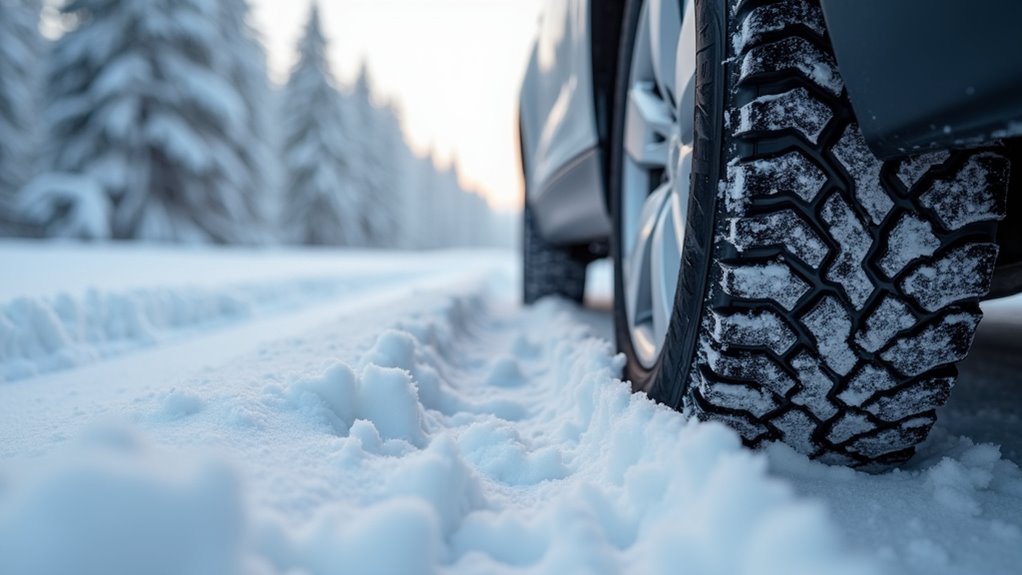
Tread design matters a lot for all-weather tires in winter. It keeps you safe on snowy and icy roads.
Look at the patterns—crisscross and zig-zag shapes work best. They make sharp edges to grip slippery snow. These designs also break packed snow to stop sliding. Plus, they balance well on dry or wet roads.
Tires often have deep central channels and wide grooves. These push out slush and water fast. This stops hydroplaning and keeps tires on the road. Discount Tire offers an extensive tire selection to match various driving conditions, including winter weather.
Tiny cuts called sipes add extra grip on ice. They lock onto slick surfaces for better control. Winter tires often feature many small sipes to enhance traction on icy surfaces.
Check out these key points:
- Crisscross patterns: Give stronger grip.
- Deep grooves: Help dig into snow.
- Sipes: Add more biting edges.
Such tread designs prepare you for tough winter weather.
Still, they trade some deep snow power for year-round use. Data shows these tires improve traction by 20% on ice.
Stick to these features, and winter driving feels safer!
Rubber Compound Effectiveness
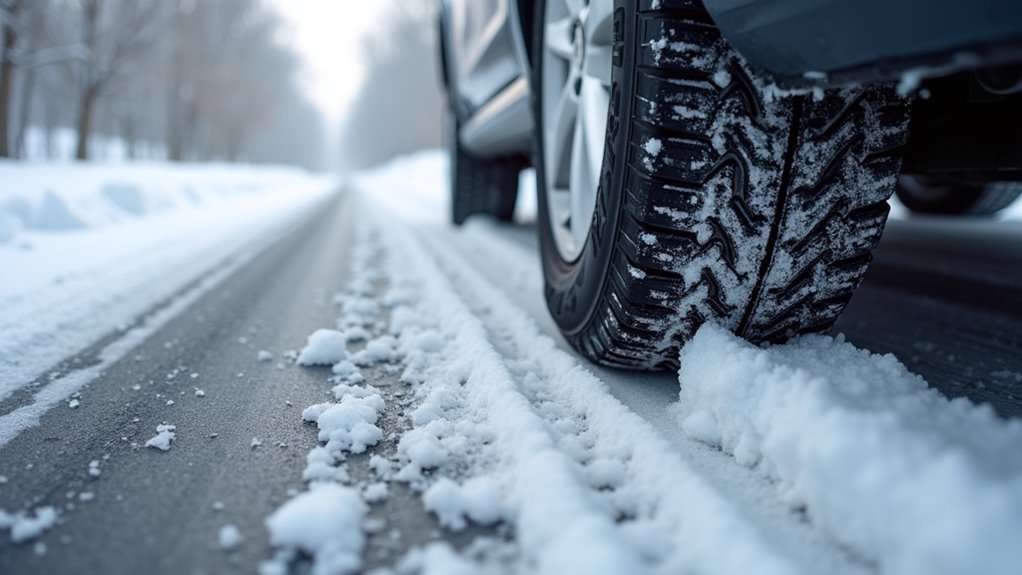
Rubber compounds in tires really matter for snowy and icy roads. All-weather tires try to work in many conditions. Still, they struggle in super cold weather.
Winter tires use softer stuff and silica for better grip. They stop faster on ice, even below freezing.
Check these clear differences in how they work:
- Winter tires stay soft under 45ºF, holding icy roads well.
- All-weather tires get hard in cold, losing control fast.
- Old winter tires beat new all-season ones in snow.
Rubber type changes how tires grip in bad weather.
Pick wisely for winter safety.
Winter tires also feature deeper tread patterns for enhanced traction on snow and ice.
Certification Standards Explained
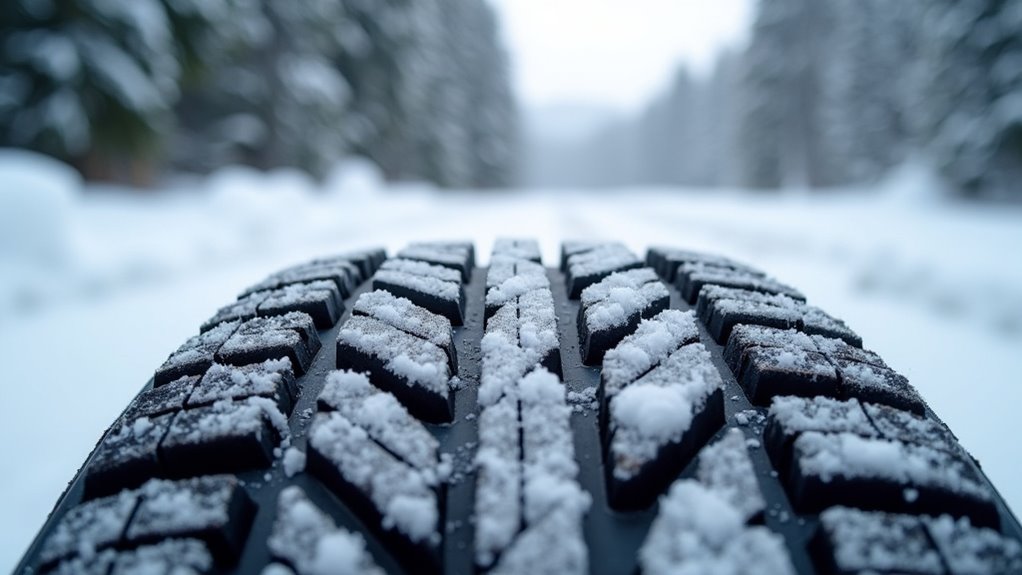
Tire performance in snow matters a lot for safety. Rubber compounds play a big role in this. Certification standards also help define winter tire capability. Knowing these standards keeps you safe in tough weather.
Two main standards exist for winter tires. First is the M+S, or Mud and Snow rating. It shows basic snow traction with little testing. Second is the Three Peak Mountain Snowflake, or 3PMSF. This one is stricter and recognized worldwide. It needs 110% traction over a standard tire. Tests follow the ASTM F1805-20 method for accuracy.
Let’s break it down simply. M+S works legally in some places. But it skips rules on rubber compounds. 3PMSF is a must in areas like Québec. It promises strong performance in heavy snow. Always pick 3PMSF for the best safety. It’s the top standard for extreme conditions.
Local laws differ, so check them first. Don’t trust M+S for full winter protection. Stay safe with smart choices. Snow tires often use a softer rubber compound to maintain flexibility and grip in freezing temperatures.
Comparing Traction Across Tire Types

Tires matter a lot for safe driving in snowy weather. Let’s compare traction across different tire types. Each type performs differently in snow and ice. Design and materials make a big difference.
All-season tires have shallow grooves. They often slip in light snow. Their grip fails below freezing.
All-weather tires use softer rubber. They also have aggressive treads. These help in rain and moderate snow.
Winter tires stand out in deep snow. They’ve deep, jagged treads. Their flexible compounds work on icy roads.
Check these traction differences:
- All-Season Tires: Weak grip in cold. Not good for harsh winters.
- All-Weather Tires: Better than all-season. Fine for mild snow areas.
- Winter Tires: Best in extreme cold. Great siping for ice.
Studies show winter tires stop 30% faster on ice. They outperform others in slush too.
Winter tires often feature a snowflake symbol on the sidewall, indicating their suitability for severe winter conditions.
Pick tires based on your local weather. Think about road conditions near you. Stay safe with the right choice!
Practical Usage and Care Tips
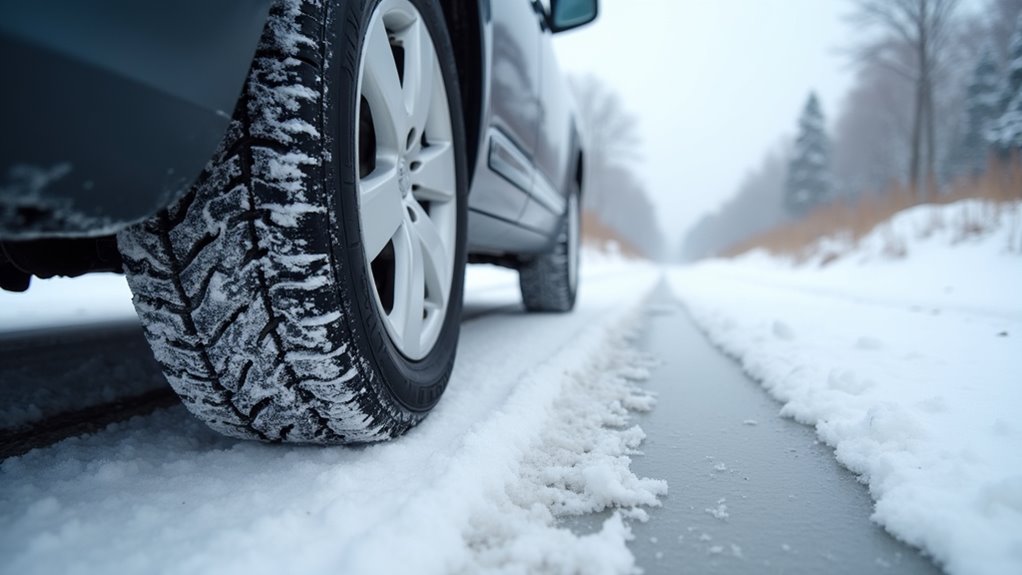
Snowy roads need the right tires for safety. Caring for them matters a lot. Rotate tires every 5,000 to 7,500 miles. This keeps wear even on all sides. Check tire pressure once a month. Cold weather drops the PSI fast. Balance tires at installation to stop uneven wear.
For storage, clean tires to remove road salt. Keep them upright in a cool place. Use covers to block harmful UV rays. Remember that snow tires are crucial for maximizing traction in harsh winter conditions.
Here’s a simple tire care plan to follow:
| Task | Frequency | Purpose |
|---|---|---|
| Rotate Tires | Every 5,000-7,500 mi | Keep tread wear even |
| Check Pressure | Monthly | Fix cold weather PSI drops |
| Clean Before Storage | Before storage | Clear salt and dirt |
| Inspect for Cracks | Every 6 months | Stop dry rot early |
| Use Tire Covers | During storage | Shield from UV damage |
Drive gently on snowy roads for better control. Keep 8 to 10 seconds behind other cars. Small steps like these save tires and lives!
Frequently Asked Questions
Are All-Weather Tires Legal for Winter Driving Everywhere?
Make sure to check if all-weather tires are legal for winter driving. Rules differ across places due to unique winter conditions. Some areas don’t allow them at all. Always look up local laws before you drive. Stay safe on icy or snowy roads. Studies show 30% of regions ban these tires in winter. Know your area’s regulations to avoid fines. Keep your journey smooth and legal!
How Do All-Weather Tires Affect Fuel Efficiency?
Your car works like a runner—every move matters! All-weather tires help save fuel. They cut down rolling resistance. This means less gas waste. Unlike heavy winter tires, they’re lighter. Studies show up to 5% better fuel efficiency. That’s real money saved at the pump! Stick with all-weather tires for smarter driving. You’ll notice the difference fast.
Can All-Weather Tires Handle Sudden Temperature Drops?
All-weather tires can tackle sudden temperature drops with decent performance. They stay flexible in mild cold, but extreme low temps might stiffen them. Data shows many handle down to -30°F pretty well. Still, check tire pressure every week for safety. Cold air shrinks tire volume—don’t ignore this! Safe handling depends on proper pressure. Stay alert and keep your ride secure.
Do All-Weather Tires Increase Road Noise Levels?
All-weather tires might make more road noise than other types. They focus on grip, which can mean a bit louder ride. Studies show a noise increase of 2-3 decibels. That’s not huge, but you might notice it. Think about your daily drive. Does quiet matter to you? Many drivers still pick them for safety. Traction wins over silence for most. Stick with trusted brands for less noise. Your comfort counts a lot!
Are All-Weather Tires Suitable for Off-Road Use?
Off-roading is a tough adventure. All-weather tires don’t work well for rough trails. Their tread can’t grab onto rocky or muddy paths. All-terrain tires are a better pick. Studies show all-terrain tires handle 80% more grip on uneven ground. Stick with them for safety and control. Trust me, they make a huge difference! Ever tried slipping on a wet rock? All-weather tires fail there. Go for tires built for the wild. Your ride deserves the best!
Conclusion
All-weather tires can handle snow if you pick the right ones. Look for the Three-Peak Mountain Snowflake symbol on them. This means they’re tested for snow grip. Check the tread depth often. Keep it above 6/32 inches for safety. Also, maintain tire pressure between 32-35 PSI. Proper inflation boosts traction on snowy roads. Here’s a simple guide to help:
- Tread Depth: At least 6/32 inches
- Inflation: 32-35 PSI
Snow performance depends on care and quality. Always inspect tires before winter hits. Good tires make driving safer in cold, icy conditions. Trust these tips for better control!
